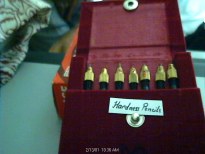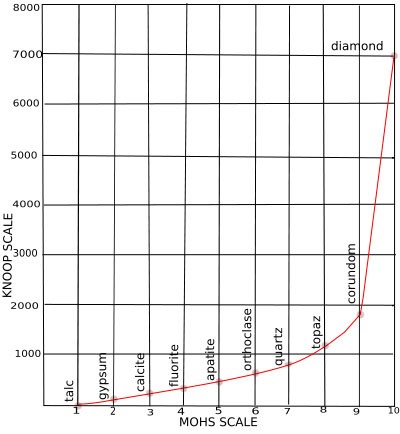
Copyright 2009-2014 Mahavir Gems. All Rights Reserved.
MAHAVIR GEMS

This site is best viewed on 1024 x 768 screen resolution using Mozilla 3.5 Browser
Important identification tool in the fields of geology & gemology
History of Mohs hardness scale
In the early 19th century, Friedrich Mohs developed a scale of relative hardness for minerals. He composed a list of 10 minerals with known hardness and organized them on an ascending scale, with talc at the lower end and diamond at the highest end.
This scale indicates that corundum can scratch topaz (and all others lower on the list) but not diamond.
It should be noted that this is not a linear scale. The difference in actual hardness between diamond and corundum is 10 times higher than the difference between talc and corundum. Thus it is a comparative hardness scale, with the hardness of one mineral relative to another mineral on the list.
As can be seen in the list, quartz has a hardness of 7 on Mohs scale. Quartz is one of the most abundant minerals on Earth and is even in dust particles that constantly float through the air. This is why minerals with a hardness less than 7 will abrade relatively rapidly with normal wear.
Of course, all minerals could be put on the scale, but that would create an almost endless list.
The method of testing the hardness of gemstones is by the use of hardness pencils
Hardness pencils
Hardness pencils are pencils with a tip made of one of the 10 natural gemstones / minerals on Mohs scale.
These pencils are used to try and scratch a stone and observe if the pencils can scratch the gem. Since this is a destructive method (it leaves a scratch), this test is mostly used on pieces of rough or on a inconspicuous place on the gemstone. Not many gemologists use this test as there are better ways to determine a gemstone's identity.
When one does feel the need to apply this test, one must do it in a logical manner.
The gemstone is tested with a pencil of low hardness (starting at 4 or lower) to try to put a tiny scratch on the stone without applying pressure. If no scratch is observed, one repeats this process with a pencil of higher hardness (in this case 5) and so on until one arrives at the pencil that is able to put a tiny scratch on the stone.
For example, if one is not able to scratch the mineral with pencil no.6 but it would leave a scratch with pencil no.7, the hardness of the mineral must be between 6 and 7 on Mohs scale.

Mohs vs Knoop Scale Diagram
Mineral
|
Mohs
|
Knoop
|
Talc
Gypsum
Calcite
Fluorite
Apatite
Feldspar
Quartz
Topaz
Corundum
Diamond
|
1
2
3
4
5
6
7
8
9
10
|
1
32
135
163
430
560
820
1340
1800
7000
|
Mineral Scales of Hardness
Examples of Common Items and Their Relative Hardness on the Mohs Scale
Hardness
|
Substance or Mineral
|
1
2.5
2.5-3
3
4-4.5
4-5
5.5
6
6-7
7
7-7.5
7-8
7.5
8
8.5
9
10
|
Graphite or pencil lead, talcum powder
Average fingernail
Pure gold, silver or aluminum
Copper Penny , limestone
Platinum
Iron
Knife Blade
Titanium
Glass
Quartz (ex: amethyst and tigers eye)
Garnet
Hardened Steel
Tungsten
Topaz, Emeralds, Aquamarines
Chromium
Sapphires, Rubies
Diamonds
|


